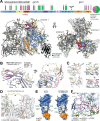Molecular insights into antibody-mediated protection against the prototypic simian immunodeficiency virus
- PMID: 36068229
- PMCID: PMC9446601
- DOI: 10.1038/s41467-022-32783-2
Molecular insights into antibody-mediated protection against the prototypic simian immunodeficiency virus
Abstract
SIVmac239 infection of macaques is a favored model of human HIV infection. However, the SIVmac239 envelope (Env) trimer structure, glycan occupancy, and the targets and ability of neutralizing antibodies (nAbs) to protect against SIVmac239 remain unknown. Here, we report the isolation of SIVmac239 nAbs that recognize a glycan hole and the V1/V4 loop. A high-resolution structure of a SIVmac239 Env trimer-nAb complex shows many similarities to HIV and SIVcpz Envs, but with distinct V4 features and an extended V1 loop. Moreover, SIVmac239 Env has a higher glycan shield density than HIV Env that may contribute to poor or delayed nAb responses in SIVmac239-infected macaques. Passive transfer of a nAb protects macaques from repeated intravenous SIVmac239 challenge at serum titers comparable to those described for protection of humans against HIV infection. Our results provide structural insights for vaccine design and shed light on antibody-mediated protection in the SIV model.
© 2022. The Author(s).
Conflict of interest statement
The authors declare no competing interests.
Figures






Similar articles
-
Breakthrough of SIV strain smE660 challenge in SIV strain mac239-vaccinated rhesus macaques despite potent autologous neutralizing antibody responses.Proc Natl Acad Sci U S A. 2015 Aug 25;112(34):10780-5. doi: 10.1073/pnas.1509731112. Epub 2015 Aug 10. Proc Natl Acad Sci U S A. 2015. PMID: 26261312 Free PMC article.
-
Limited impact of passive non-neutralizing antibody immunization in acute SIV infection on viremia control in rhesus macaques.PLoS One. 2013 Sep 9;8(9):e73453. doi: 10.1371/journal.pone.0073453. eCollection 2013. PLoS One. 2013. PMID: 24039947 Free PMC article.
-
Isolation and Structure of an Antibody that Fully Neutralizes Isolate SIVmac239 Reveals Functional Similarity of SIV and HIV Glycan Shields.Immunity. 2019 Oct 15;51(4):724-734.e4. doi: 10.1016/j.immuni.2019.09.007. Epub 2019 Oct 2. Immunity. 2019. PMID: 31586542
-
Nonneutralizing functional antibodies: a new "old" paradigm for HIV vaccines.Clin Vaccine Immunol. 2014 Aug;21(8):1023-36. doi: 10.1128/CVI.00230-14. Epub 2014 Jun 11. Clin Vaccine Immunol. 2014. PMID: 24920599 Free PMC article. Review.
-
Fusion peptide-directed antibodies: Humoral armor against HIV-1 infection.Sci Transl Med. 2024 Jan 17;16(730):eadl2162. doi: 10.1126/scitranslmed.adl2162. Epub 2024 Jan 17. Sci Transl Med. 2024. PMID: 38232137 Review.
Cited by
-
Potent broadly neutralizing antibodies mediate efficient antibody-dependent phagocytosis of HIV-infected cells.PLoS Pathog. 2024 Oct 28;20(10):e1012665. doi: 10.1371/journal.ppat.1012665. eCollection 2024 Oct. PLoS Pathog. 2024. PMID: 39466835 Free PMC article.
-
Combining a rhesus cytomegalovirus/SIV vaccine with a neutralizing antibody to protect against SIV challenges in rhesus macaques.Front Microbiol. 2025 Jun 2;16:1592647. doi: 10.3389/fmicb.2025.1592647. eCollection 2025. Front Microbiol. 2025. PMID: 40529575 Free PMC article.
-
Potent antibody-dependent cellular cytotoxicity of a V2-specific antibody is not sufficient for protection of macaques against SIV challenge.PLoS Pathog. 2024 Jan 22;20(1):e1011819. doi: 10.1371/journal.ppat.1011819. eCollection 2024 Jan. PLoS Pathog. 2024. PMID: 38252675 Free PMC article.
-
CD8+ cells and small viral reservoirs facilitate post-ART control of SIV replication in M3+ Mauritian cynomolgus macaques initiated on ART two weeks post-infection.PLoS Pathog. 2023 Sep 25;19(9):e1011676. doi: 10.1371/journal.ppat.1011676. eCollection 2023 Sep. PLoS Pathog. 2023. PMID: 37747933 Free PMC article.
-
Adeno-associated viral delivery of Env-specific antibodies prevents SIV rebound after discontinuing antiretroviral therapy.bioRxiv [Preprint]. 2024 Jun 3:2024.05.30.593694. doi: 10.1101/2024.05.30.593694. bioRxiv. 2024. Update in: Sci Immunol. 2025 Feb 28;10(104):eadq4973. doi: 10.1126/sciimmunol.adq4973. PMID: 38895320 Free PMC article. Updated. Preprint.
References
Publication types
MeSH terms
Substances
Grants and funding
- 75N91019D00024/CA/NCI NIH HHS/United States
- R61 AI161818/AI/NIAID NIH HHS/United States
- HHSN261200800001E/CA/NCI NIH HHS/United States
- HHSN261201500003C/CA/NCI NIH HHS/United States
- R33 AI161818/AI/NIAID NIH HHS/United States
- P30 AI073961/AI/NIAID NIH HHS/United States
- HHSN261201500003I/CA/NCI NIH HHS/United States
- P51 OD011106/OD/NIH HHS/United States
- C06 RR020141/RR/NCRR NIH HHS/United States
- C06 RR015459/RR/NCRR NIH HHS/United States
- UM1 AI144462/AI/NIAID NIH HHS/United States
- R01 AI052056/AI/NIAID NIH HHS/United States
- UM1 AI100663/AI/NIAID NIH HHS/United States
LinkOut - more resources
Full Text Sources
Medical

